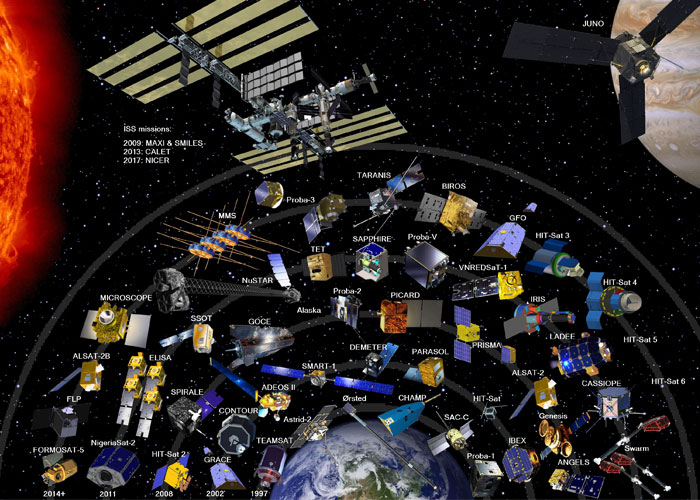Four NASA spacecraft are to study the Earth’s magnetic fields. Star cameras from DTU will be used to handle the navigation
In March, the American space agency NASA will be launching four new spacecraft—each fitted with four star cameras from DTU Space. The new NASA mission is scheduled to blast off on 12 March 2015, if wind and weather conditions are favourable at Cape Canaveral in Florida. The mission has been named MMS (Magnetospheric Multiscale), and comprises four identical vessels, each fitted with a quadruple star camera designed and hand-built at DTU Space.
The cameras are intended to ensure that the vessels remain in the correct position in space. As each of the craft is fitted with a 120-metre-long boom and has to fly in a precisely planned formation, maintaining internal spacing of 10 km, and a distance from the Earth of between 900 and 150,000 km, accurate control of the vessels in space is quite simply crucial to the success of the mission.
The objective of the MMS mission is to explore the phenomenon of magnetic reconnection, which is still not completely understood. Magnetic reconnection is the term for the process that takes place when two magnetic fields connect and then disconnect again. The connection is accompanied by an explosive transfer of energy. Magnetic reconnection takes place throughout the universe. It is also often observed in the Sun, where it causes solar flares.
Closer to Earth—where the MMS vessels are to take up their positions—magnetic reconnection occurs when particles from solar flares come into contact with the Earth’s magnetic field. This interaction is similarly accompanied by huge yet invisible transfers of energy between the Earth and the Sun. These energy transfers affect what is known as ‘space weather’, which causes the electrical storms that create the magnificent Northern Lights, but can also disrupt the electronic components in satellites and cause leakage current in electrical circuits on Earth. This is a problem that primarily affects long high-voltage cables, and which can cause power outages in the electricity grid.
"The star cameras from DTU Space have been specially designed for the MMS mission, and they are considered key components in the vessels’ control systems."
Samuel J. Placanica, Chief Engineer on the MMS Attitude Control System.
[video:1]
Improved space weather forecasts
So the process of magnetic reconnection is familiar, and researchers have already established that it can occur in narrow lines just a few kilometres wide. However, it is still not known precisely what triggers the phenomenon. The MMS vessels are to fly through areas around the Earth where magnetic reconnection is known to occur, and— it is hoped—to capture incidences of magnetic reconnection while they are actually taking place.
Full comprehension of the process may lead to improved ‘space weather forecasts’, thus helping to prevent the unfortunate consequences of electrical storms, and to provide a better understanding of the mechanisms behind the acceleration of energy-rich cosmic radiation.

Staff at NASA are inspecting the star camera from DTU Space. Photo: NASA.
DTU Space and NASA have been working together for almost two decades, and NASA has already used the star cameras on a number of missions. NASA is clearly delighted to have the DTU technology on its MMS vessels:
“The star cameras from DTU Space have been specially designed for the MMS mission, and they are considered key components in the vessels’ control systems. After launch, the cameras on the four spacecraft will supply the control systems with data that will allow us to establish their position and speed with remarkable accuracy. This is a demanding task, given that each vessel is to rotate on its own axis three times per minute while maintaining its position in a set geometric formation,” says Samuel J. Placanica, Chief Engineer on the MMS Attitude Control System.
Only in September will the four vessels that make up the MMS mission be in position to start investigating the phenomenon of magnetic reconnection around the Earth.
Article in DTUavisen no. 3, March 2015.
The star cameras are used as a ‘compass’ for the spacecraft, allowing researchers to pinpoint their position in space.
A stellar compass comprises two main parts:
- a digital camera that photographs the night sky
- a computer that matches the digital images against a stellar map stored in the computer.
The stellar compass compares the photographic image with the stellar map to define the exact position of the spacecraft.

Thus far, DTU Space has supplied stellar compasses for more than 50 international missions in space.